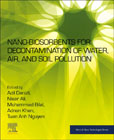
Nano-biosorbents for Decontamination of Water, Air, and Soil Pollution
Denizli, Adil
Ali, Nisar
Bilal, Muhammad
Khan, Adnan
Nguyen, Tuan Anh
Nano-biosorbents for Decontamination of Water, Air, and Soil Pollution explores the properties of nanobiosorbents and their applications in the removal of contaminants from the natural environment. The use of nanobiosorbents for environmental protection is a combinational approach that incorporates nanotechnology with naturally occurring biopolymers that form an amalgamation of nano-biopolymers used as sorbent materials in the removal of a variety of contaminants from wastewaters. This is an important reference source for materials scientists, bioscientists and environmental scientists who are looking to understand how nanobiosorbents are being used for a range of environmental applications. Highlights the environmental applications of chitosan-based, cellulose-based and polymer-based nanoscale biosorbents Explains the advantages of using different types of nanobiosorbents for soil, water and air purification applications Assesses the challenges associated with manufacturing nanobiosorbents cheaply and on an industrial scale INDICE: Section I: Basics principles 1. Nano-biosorbents for contaminant removal: An introduction 2. Introduction to nano-biosorbents 3. Nanobiosorbents: Basic principles, synthesis, and application for contaminants removal 4. Methods for the synthesis of nanobiosorbents for the contaminant removal 5. An insight into the potential contaminants, their effects, and removal means 6. Advantages of nanoadsorbents, biosorbents, and nanobiosorbents for contaminant removal 7. Nanomaterials for removal of heavy metals from wastewater 8. Nanosorbents for heavy metals removal 9. Non-toxic nature of nano-biosorbents as a positive approach toward green environment 10. Nanoadsorbents for environmental remediation of polluting agents Section II: Cellulose-based nanobiosorbents for decontamination of environmental matrices 11. Risk assessment of nanocellulose exposure 12. Cellulose-based nanobiosorbents: An insight 13. Synthesis and properties of cellulosebased nanobiosorbents 14. Introduction to cellulose-based nanobiosorbents 15. Cellulose composites as nanobiosorbents for ecological remediation 16. Modification and derivatization of cellulose-based nanobiosorbents and their utilization in environmental remediation 17. Cellulose-based nano-biosorbents in water purification Section III: Chitosan-based nanobiosorbents for deterioration of environmental matrices 18. Toxic metals adsorption from water using chitosan nanoderivatives 19. Toxicological impact and adsorptive removal of triclosan from water bodies using chitosan and carbon-based nano-architectures Section IV: Multifarious biopolymers as nanobiosorbents for decontamination of environmental matrices 20. Citrus waste-based sorbent for wastewater treatment 21. Alginate-based nanobiosorbents for bioremediation of environmental pollutants 22. Synthesis of novel nanobioadsorbent for the effective removal of Pb2+ and Zn2+ ions-Adsorption, equilibrium, modeling, and optimization studies 23. Nanocrystalline NiO powder: Synthesis, characterization and emerging applications 24. Attraction to adsorption: Preparation methods and performance of novel magnetic biochars for water and wastewater treatment 25. Biomass-derived nanocomposites: A critical evaluation of their performance toward the capture of inorganic pollutants 26. Magnetic nanomaterials-based biosorbents
- ISBN: 978-0-323-90912-9
- Editorial: Elsevier
- Encuadernacion: Rústica
- Páginas: 646
- Fecha Publicación: 02/07/2022
- Nº Volúmenes: 1
- Idioma: Inglés
